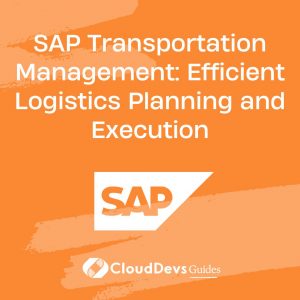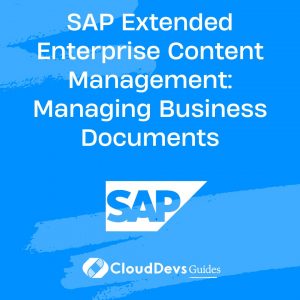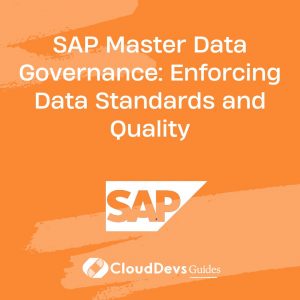SAP Transportation Management: Efficient Logistics Planning and Execution
In today’s fast-paced global business landscape, efficient logistics planning and execution are critical for success. Companies need to optimize their supply chain operations to reduce costs, improve customer satisfaction, and stay competitive. This is where SAP Transportation Management (SAP TM) comes into play. SAP TM is a robust solution that helps organizations streamline their transportation processes, making logistics management more efficient and effective. In this blog, we will explore the key features and benefits of SAP TM and how it can revolutionize your logistics operations.
1. Understanding the Importance of Logistics Management
Before delving into SAP TM, it’s essential to understand why logistics management is so crucial for businesses. Logistics encompasses the planning, execution, and control of the flow of goods and services from point A to point B. Effective logistics management ensures that products are delivered to the right place at the right time while minimizing costs and optimizing resources. Inefficient logistics processes can lead to delayed deliveries, increased expenses, and unhappy customers.
1.1. Challenges in Logistics Management
Logistics management faces several challenges in today’s dynamic business environment:
- Complex Supply Chains: With globalization, supply chains have become more complex, involving multiple suppliers, carriers, and distribution centers across the globe.
- Rising Transportation Costs: Fuel prices, labor costs, and regulatory changes can lead to unpredictable and rising transportation expenses.
- Customer Expectations: Customers now expect faster deliveries and real-time visibility into their shipments.
- Environmental Concerns: Sustainability and environmental regulations have added an extra layer of complexity to logistics operations.
To address these challenges, organizations need a comprehensive solution that can optimize their transportation processes.
2. Introducing SAP Transportation Management (SAP TM)
SAP TM is a specialized software solution designed to address the complexities of modern logistics management. It is part of SAP’s larger suite of supply chain management solutions, offering a range of features to streamline transportation processes.
2.1. Key Features of SAP TM
Let’s take a closer look at some of the key features that make SAP TM a game-changer in logistics planning and execution:
2.1.1. Transportation Planning and Optimization
SAP TM provides advanced algorithms to optimize transportation plans, taking into account various factors such as order constraints, carrier capacity, and delivery time windows. This optimization leads to more efficient route planning and cost reductions.
python # Sample code for transportation planning using SAP TM from sap.tm import TransportationPlanner planner = TransportationPlanner() optimized_plan = planner.optimize_transportation_plan()
2.1.2. Real-time Visibility
Real-time visibility is crucial in logistics management. SAP TM offers real-time tracking of shipments, allowing you to monitor the status and location of your goods at any given moment. This visibility helps in proactively addressing any delays or issues.
java
// Java code for real-time shipment tracking with SAP TM
ShipmentTracker tracker = new ShipmentTracker();
LocationStatus status = tracker.getShipmentStatus("SHIP123");
2.1.3. Carrier Collaboration
SAP TM enables seamless collaboration with carriers and partners. It provides a platform for communication and coordination, ensuring that everyone involved in the transportation process is on the same page.
csharp
// C# code for carrier collaboration in SAP TM
CarrierCollaborator collaborator = new CarrierCollaborator();
collaborator.sendReal-timeUpdates("SHIP456", "On-time delivery expected.");
2.2.4. Compliance and Documentation
Meeting regulatory requirements and handling documentation is simplified with SAP TM. It generates the necessary shipping documents and ensures compliance with international trade regulations.
sql -- SQL code to generate shipping documents in SAP TM EXEC sp_generate_shipping_documents @shipment_id = 'SHIP789';
2.2.5. Analytics and Reporting
SAP TM offers powerful analytics and reporting tools, allowing you to gain insights into your transportation operations. You can track key performance indicators (KPIs) and make data-driven decisions to optimize your logistics processes further.
javascript
// JavaScript code for generating transportation KPI reports
const analytics = require('sap-tm-analytics');
const kpiReport = analytics.generateKPIReport();
3. Benefits of SAP TM
Now that we’ve explored some of the key features of SAP TM, let’s discuss the tangible benefits it brings to organizations:
3.1. Cost Reduction
By optimizing transportation plans and routes, SAP TM helps reduce transportation costs significantly. This cost-saving directly impacts the bottom line and improves profitability.
3.2. Improved Customer Service
Real-time visibility and efficient planning lead to faster deliveries and better customer service. Satisfied customers are more likely to become repeat customers.
3.3. Enhanced Decision-Making
With access to analytics and reporting, organizations can make informed decisions to improve their logistics operations continuously.
3.4. Regulatory Compliance
SAP TM ensures that your organization complies with all transportation regulations, reducing the risk of fines and legal issues.
3.5. Sustainability
Efficient transportation planning and reduced fuel consumption contribute to a more sustainable supply chain, aligning with environmental goals.
4. Implementing SAP TM
Implementing SAP TM is a strategic decision that requires careful planning and execution. Here are the general steps involved in implementing SAP TM:
4.1. Assessment and Planning
Evaluate your current logistics processes and identify areas that need improvement. Define your goals and objectives for implementing SAP TM.
4.2. System Configuration
Customize SAP TM to align with your organization’s specific requirements. This includes defining transportation rules, carrier contracts, and other parameters.
4.3. Data Migration
Transfer existing transportation data into SAP TM. Ensure data accuracy and consistency during this phase.
4.4. Testing
Thoroughly test the system to ensure that it performs as expected. Test various transportation scenarios to validate the optimization algorithms.
4.5. Training
Train your staff to use SAP TM effectively. Provide training on the system’s features and functionality.
4.6. Go-live and Support
Gradually transition to SAP TM for your transportation management. Provide ongoing support and maintenance to address any issues that arise.
Conclusion
In today’s competitive business landscape, efficient logistics planning and execution are vital for success. SAP Transportation Management (SAP TM) offers a comprehensive solution to address the complexities of modern logistics, from transportation planning and optimization to real-time visibility and compliance. By implementing SAP TM, organizations can reduce costs, improve customer service, and gain a competitive edge in the market. If you’re looking to streamline your logistics operations and enhance your supply chain efficiency, SAP TM is a powerful tool to consider. Embrace the future of logistics with SAP TM and stay ahead of the competition.
Table of Contents









